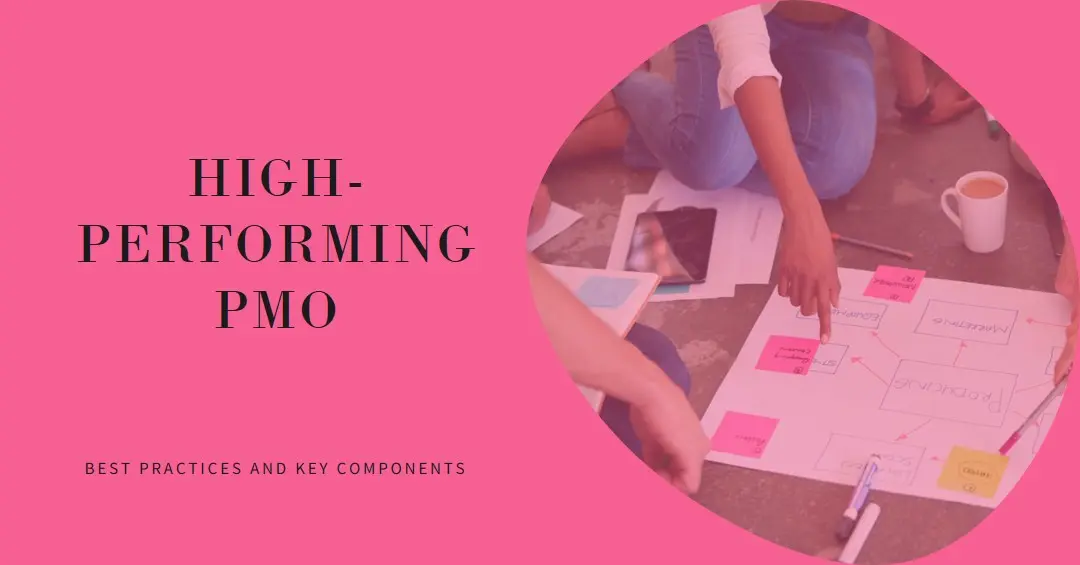I Introduction
Hey there, project management enthusiasts! Are you looking to take your organization’s project management capabilities to the next level? Well, you’ve come to the right place. In today’s fast-paced business environment, having an effective Project Management Office (PMO) can make all the difference in ensuring your projects run smoothly, meet objectives, and deliver value. In this post, we’ll dive into the best practices and key components you need to establish a high-performing PMO that drives success across your organization.
But first, let’s quickly define what a PMO is. A PMO, or Project Management Office, is a centralized team or department within an organization that is responsible for defining and maintaining project management standards, practices, and methodologies. The PMO’s primary goal is to ensure that projects are executed consistently and efficiently, maximizing the chances of achieving desired outcomes.
Now, you might be wondering why it’s essential to establish a high-performing PMO. The answer is simple: A well-functioning PMO can help your organization avoid costly project failures, improve resource allocation, and enhance overall project delivery. In other words, it’s an investment in your organization’s long-term success.
In the sections to follow, we’ll explore several crucial aspects of building a successful PMO, such as effective goal-setting, communication, team building, and performance measurement. By the end of this post, you’ll have a solid understanding of the necessary components and best practices to implement in your organization and transform your PMO into a powerhouse that drives success. So, let’s get started!
II Goal-Setting
Welcome to the first step of establishing a high-performing PMO: goal-setting! You might have heard the saying, “If you don’t know where you’re going, any road will take you there.” That’s why it’s vital to have a clear vision of what you want your PMO to achieve. Setting well-defined, realistic objectives not only gives your PMO direction but also helps you measure progress and success.
To ensure your PMO’s goals align with your organization’s broader objectives, it’s crucial to involve key stakeholders in the goal-setting process. This collaborative approach will make it easier to secure buy-in and support from different departments and teams.
When setting goals, I highly recommend using the SMART criteria. If you’re not familiar with it, SMART stands for Specific, Measurable, Achievable, Relevant, and Time-bound. By ensuring your goals meet these criteria, you’ll create a clear and actionable roadmap for your PMO’s success.
Here are some tips for prioritizing and revisiting your PMO’s goals:
- Break larger goals into smaller, manageable milestones. This approach can help you track progress more effectively and make necessary adjustments along the way.
- Regularly review your goals with your team and stakeholders. This practice will ensure everyone remains focused and aligned, and it also creates opportunities for feedback and refinement.
- Be open to change. As your organization evolves, so will its needs and priorities. Stay flexible and adapt your PMO’s goals as necessary to continue delivering value.
- Celebrate your achievements! Recognizing your team’s hard work and accomplishments will boost morale and motivate them to strive for even greater success.
Now that we’ve covered goal-setting let’s move on to another critical component of a high-performing PMO: communication. Stay tuned for some tips and strategies to ensure your PMO’s communication is top-notch!
III Communication
Ah, communication – the lifeblood of any successful project and PMO! When it comes to establishing a high-performing PMO, effective communication is an absolute must. It’s what keeps everyone on the same page, fosters collaboration, and enables informed decision-making. So let’s dive into some strategies and tips for ensuring top-notch communication within your PMO.
First, it’s essential to establish clear communication channels and protocols. This means determining how your team will share information, updates, and feedback, as well as the preferred tools and platforms for communication. Having well-defined communication processes in place will help you avoid misunderstandings, minimize information overload, and ensure everyone has access to the information they need when they need it.
Here are some strategies to promote information sharing and collaboration within your PMO:
- Hold regular meetings: Schedule recurring team meetings and touchpoints, such as weekly status updates, monthly progress reviews, or daily stand-ups, to maintain open communication and ensure everyone stays informed.
- Create a centralized information hub: Use a shared platform, like a project management tool or intranet, where team members can easily access project documents, updates, and other essential resources.
- Foster a culture of open communication: Encourage team members to ask questions, share ideas, and provide feedback. This open dialogue can help identify potential issues early on and promote a more collaborative environment.
But what about overcoming communication barriers and challenges? Here are some tips:
- Address language and cultural differences: If your PMO includes team members from diverse backgrounds, be mindful of potential language barriers and cultural differences. Offer translation support when needed, and foster an inclusive environment that values and respects diversity.
- Be mindful of remote team members: With the increasing prevalence of remote work, it’s essential to ensure remote team members have equal access to information and opportunities to participate in discussions. Leverage video conferencing and collaboration tools to keep everyone connected.
- Tailor your communication style: Recognize that not everyone communicates in the same way. Be adaptable and adjust your communication style to suit your audience, whether it’s a one-on-one conversation with a team member or a presentation to stakeholders.
By prioritizing effective communication within your PMO, you’re setting the stage for a more collaborative, efficient, and successful environment. Up next, we’ll talk about another essential building block for a high-performing PMO: team building. Stay tuned!
IV Team Building
You’ve made it to one of my favorite topics: team building! A high-performing PMO is only as strong as the people behind it. So, let’s explore how to assemble a skilled, diverse, and motivated team that works together like a well-oiled machine.
Building a top-notch PMO team starts with recruiting the right mix of talent. Look for individuals with diverse skill sets, backgrounds, and experiences, as this variety will foster creativity and innovation within your team. Of course, it’s crucial to ensure all team members have a solid foundation in project management principles and practices, but don’t overlook the importance of soft skills like communication, problem-solving, and adaptability.
Once you’ve assembled your dream team, it’s time to focus on creating a strong team culture and building trust. Here are some tips to help you do just that:
- Encourage collaboration: Promote a culture where team members work together, share ideas, and support each other. This atmosphere will not only improve the quality of your team’s work but also boost morale and job satisfaction.
- Provide opportunities for team members to connect: Schedule regular team-building activities, both work-related and social, to help your team members get to know each other and forge strong relationships.
- Lead by example: As the PMO leader, set the tone for your team’s culture and values. Demonstrate a commitment to collaboration, transparency, and continuous improvement.
Now, what about onboarding new team members and integrating them into your PMO? Here are some tips to set them up for success:
- Offer a comprehensive onboarding program: Provide new team members with a clear overview of your PMO’s goals, processes, and tools. Assign a mentor or buddy to help them navigate their new environment and answer any questions they may have.
- Set clear expectations: Clearly communicate the new team member’s role, responsibilities, and performance expectations from the outset. This clarity will help them feel more confident and enable them to contribute effectively from day one.
- Foster a supportive environment: Encourage your team members to be patient and understanding with newcomers as they learn the ropes. A supportive atmosphere will help new team members feel welcome and valued.
Finally, let’s address team challenges and conflicts. No team is perfect, and occasional issues are inevitable. The key is to identify and address them early on to prevent them from escalating. Encourage open dialogue, actively listen to your team members’ concerns, and work together to find solutions.
By focusing on team building and fostering a collaborative, supportive environment, you’ll create a solid foundation for your high-performing PMO. Next up, we’ll discuss performance measurement and how it contributes to your PMO’s success. Stay tuned!
V Performance Measurement
Great job making it this far! You’re well on your way to building a high-performing PMO. Now, let’s talk about performance measurement. You’ve set goals, established communication channels, and built a fantastic team – but how do you know if your PMO is delivering the desired results? That’s where performance measurement comes in. By tracking your PMO’s performance, you can identify areas for improvement, make data-driven decisions, and demonstrate the value your PMO brings to the organization.
To get started with performance measurement, you’ll need to identify the right key performance indicators (KPIs) for your PMO. KPIs are quantifiable metrics that help you gauge your PMO’s performance against its goals. Here are some examples of KPIs you might consider:
- Project success rate: The percentage of projects completed on time, within budget, and meeting their objectives.
- Resource utilization: The percentage of available resources (time, people, and budget) effectively used in project execution.
- Stakeholder satisfaction: The level of satisfaction among project stakeholders, as measured through surveys or interviews.
- Process efficiency: The extent to which your PMO’s processes and methodologies streamline project execution and reduce waste.
Once you’ve selected your KPIs, it’s time to start collecting and analyzing data. Utilize reports, dashboards, and other tools to monitor your PMO’s performance and identify trends or patterns that may signal a need for improvement. By regularly reviewing this data, you can make informed decisions and adjustments to optimize your PMO’s performance.
But don’t stop there! Continuously improving your PMO is an ongoing process. Encourage your team to provide feedback and share lessons learned from completed projects. By fostering a culture of continuous improvement, you’ll ensure your PMO remains agile and adaptable to your organization’s evolving needs.
With performance measurement in place, you’re well-equipped to assess your PMO’s success and make the necessary adjustments to keep it on track. Next up, we’ll explore some best practices for a high-performing PMO that will help you stay ahead of the curve. Keep going – you’re almost there!
VI Best Practices for a High-Performing PMO
Kudos to you for making it this far on your journey to establish a high-performing PMO! Now that we’ve covered goal-setting, communication, team building, and performance measurement let’s dive into some best practices that can take your PMO to new heights.
- Adopt a flexible and scalable approach: In today’s ever-changing business landscape, a rigid PMO is unlikely to thrive. Embrace flexibility and adaptability, allowing your PMO to adjust its processes and methodologies as needed to meet the unique needs of each project and your organization’s overall goals.
- Invest in ongoing professional development and training: A high-performing PMO is fueled by the expertise and skill of its team members. Encourage continuous learning by offering training opportunities, attending industry conferences, and sharing the latest project management trends and insights with your team.
- Leverage technology and tools to streamline processes: Make the most of project management software, collaboration tools, and other technologies to optimize your PMO’s processes, enhance communication, and improve overall efficiency.
- Ensure stakeholder engagement and support: Your PMO’s success is closely tied to the support of key stakeholders. Keep stakeholders informed, solicit their feedback, and involve them in decision-making to ensure their buy-in and commitment to your PMO’s objectives.
By implementing these best practices, you’ll be well on your way to creating a high-performing PMO that consistently delivers exceptional results for your organization.
VII Conclusion and Next Steps
Congratulations! You’ve made it to the end of our in-depth exploration of how to establish a high-performing PMO. It’s been quite a journey, hasn’t it? From setting SMART goals to fostering a collaborative team environment and measuring performance, you now have a solid understanding of the key components and best practices that underpin a successful PMO.
As you embark on your own PMO journey, remember that each organization is unique, and so is each PMO. Don’t be afraid to tailor the strategies and tips shared in this post to suit your specific needs and circumstances. Continuously learn, adapt, and grow – because a truly high-performing PMO is one that remains agile in the face of change.
So, what’s next? Here are a few suggestions to get you started on your PMO adventure:
- Review your organization’s current project management landscape and identify areas for improvement or gaps that a PMO could address.
- Speak with key stakeholders to gather their insights and gauge their support for a PMO initiative.
- Develop a PMO implementation plan, outlining your goals, team structure, communication strategies, and performance measurement criteria.
- Continuously monitor your PMO’s performance and adjust your approach as needed to optimize results and stay aligned with your organization’s evolving goals.
Remember, you’re not alone in this journey! Connect with other PMO professionals, share your experiences, and learn from the successes and challenges of others. And don’t forget to celebrate your achievements along the way – building a high-performing PMO is no small feat, and you deserve to be proud of your progress.
Find out more about Shaun Stoltz https://www.shaunstoltz.com/about/ This post was written by an AI and reviewed/edited by a human.



